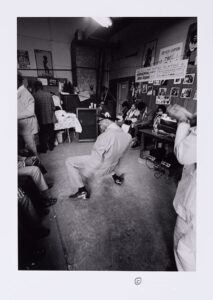CLICK HERE TO REGISTER VIA ZOOM
In conjunction with EMERGENCE: Intersections at the Center, the current exhibition at the South Side Community Art Center, the exhibition’s curators, zakkiyyah najeebah dumas-o’neal and LaMar R. Gayles, Jr., discuss the exhibition and the research that made it happen. The conversation will be moderated by Greg Foster-Rice ON ZOOM.
EMERGENCE spotlights LGBTQ artists who were part of the South Side Community Art Center’s early decades, from the 1940s to the 1990s, and presents the Center’s historical role in supporting a full spectrum of Black artists through an intersectional viewpoint.

Mikki Ferrill (born 1937). Untitled (The Garage). Gelatin silver print, 1973. Mary and Leigh Block Museum of Art, Northwestern University, The Richard Florsheim Art Fund Purchase.
zakkiyyah najeebah dumas o’neal is a visual artist, arts organizer, and educator based in Chicago.
zakkiyyah has been included in numerous group exhibitions and has had several solo exhibitions at Mana Contemporary, Blanc Gallery, Indiana University, and South Bend Museum of Art. Her work and arts programming has been presented in various forms at Museum of Contemporary Art Chicago, NADA, The Art Institute of Chicago, The August Wilson African American Cultural Center, Chicago Humanities Festival, DePaul University, and Harvard Graduate School of Design to name a few. She has also curated exhibitions at spaces such as Chicago Art Department, Blanc gallery and Washington Park Arts Incubator at the University of Chicago. She was recently an Artist in Residence at Arts and Public Life at University of Chicago and an Artist in Residence at Indiana University in Bloomington, IN.
zakkiyyah is a Co-founder and organizer of CBIM (Concerned Black Image Makers): a collective of Black artists, thinkers, and curators that prioritize shared experiences and concerns by lens based artists of the Black diaspora, through programming, exhibitions, and dialogues.
LaMar Gayles (a native son of the South Side of Chicago) is an archaeologist, independent curator, material culture scholar, and technical art historian. He is currently completing a PhD in Art Conservation and Preservation Studies at the University of Delaware after completing a MA in Museum and Exhibition Studies from University of Illinois at Chicago’s MUSE program while holding two separate positions: Archive and Collections Manager at the South Side Community Art Center and Executive Director at the Union Street Gallery. Gayles earned a Cum Laude BA with a triple major (art history, archaeology, and ethnic studies) from St. Olaf College. He has researched and curated exhibitions on Black American jewelry and its historical progressions from the seventeenth century to the twenty-first century, including the 2021 exhibition “Divine Legacies in Black Jewelry and Metals” at the National Museum of Ornamental Metals. Gayles’s research methodology combines archaeometry, arts-based research, conservation science, scientific instrumentation, art historical analysis, ethnography, historical reproduction, technical studies, and qualitative research to explore material and visual culture.
Greg Foster-Rice (he/him) is an associate professor of the history of photography at Columbia College Chicago. Most recently, he curated The Many Hats of Ralph Arnold: Art, Identity & Politics, which opened at the Museum of Contemporary Photography (2018) and travels to DePauw University in Fall 2022. For that exhibition, Foster-Rice edited and co-authored a scholarly catalogue of essays surveying Arnold’s extensive career (2018). Previously he co-curated The City Lost and Found: Capturing New York, Chicago and Los Angeles, 1960-1980 at the Art Institute of Chicago (2014) and Princeton University Art Museum (2015) and co-authored that exhibition’s catalogue which received the Philip Johnson Award from the Society of Architectural Historians. He also co-edited Reframing the New Topographics (2011) and contributed to the volumes Romare Bearden in the Modernist Tradition (2011) and Black is Black Ain’t (2013). He has a BA from Rice University and a PhD in Art History from Northwestern University.



